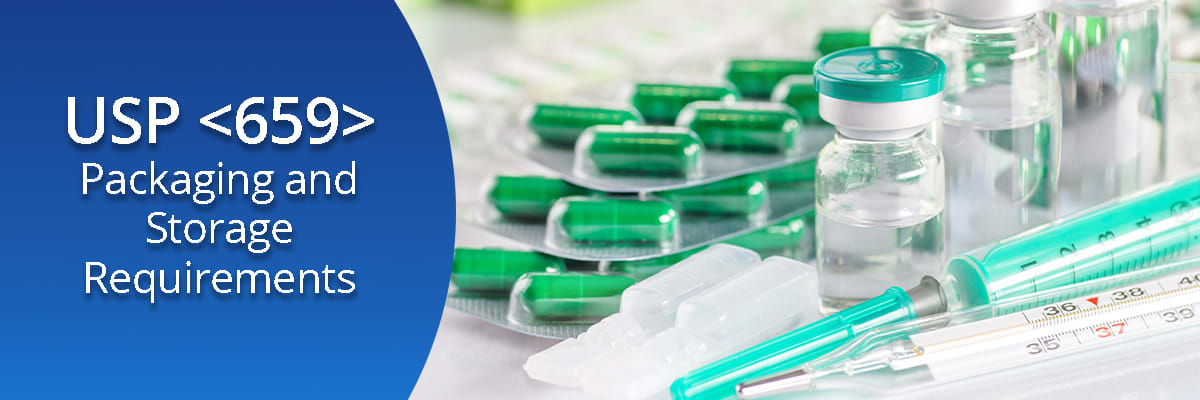Why are USP <659> Packaging and Storage Requirements Important?

For 200 years, the United States Pharmacopeia (USP) has provided guidance on drug regulations and quality standards. As scientific understanding developed and expectations for drug handling procedures became more robust, there was a necessity for USP packaging and storage requirements for pharmaceutical products. As these requirements are frequently changing, it’s important to explore not only the recommended USP storage conditions under the recently updated USP <659> but also what expectations businesses have to follow them.
What are the USP Room Temperature Storage Conditions?
While specific USP storage conditions for refrigerated medications are, it is important to understand the margin for recommended storage temperatures before exploring how changes in USP <659> have affected them.
The specific temperature requirements for medications in cold storage include:
- Freezer Storage: -25°C to +10°C
- Refrigerator Storage: +2°C to +8°C
- Cool Storage: +8°C to +15°C
- Controlled Room Temperature: +20°C to +25°C
- Room Temperature Storage: +20°C to +25°C
While there has always been allowance for temperature excursions, the updates to USP <659> have developed a new system called “controlled cold” that allows for increased temperature allowance for cool storage under certain conditions.
How “Controlled Cold” Changes USP <659> Packaging and Storage Requirements
The USP has added a new temperature definition called Controlled Cold. The Standard Refrigerated temperature is +2°C to +8°C. The added definition of Controlled Cold is +2°C to +15°C with temperature excursion time (above limits) lasting no more than 24 hours and Mean Kinetic Temperature (MKT) not to exceed +8°C. No excursions are allowed below +2°C or above +15°C. In other words, controlled cold provides some positive temperature allowance but does not permit products to get any colder than +2°C.

Standard Refrigerated Temperature vs. Controlled Cold
On the other hand, mean kinetic temperature is defined as: “…a single calculated temperature at which the total amount of degradation over a particular period is equal to the sum of the individual degradations that would occur at various temperatures” (USP 35 Chapter <1150>, Pharmaceutical Stability).
The MKT value is supposed to include the total amount of product degradation for a period of time that is equivalent to the incremental degradation that would occur in separate excursions. MKT is an additional tool that can be used to evaluate a temperature excursion.
This new Controlled Cold definition will allow refrigerated products that experience temperature excursions to be evaluated more quickly. The prior stricter +2°C to +8°C refrigerated definition required more shipments to be quarantined and evaluated. Companies can evaluate potential cost savings by reducing the number of shipments with excursions, thus reducing quality assurance time investigating excursions. TempTale® dataloggers can be programmed to the expanded +2°C to +15°C with 8°C MKT to potentially reduce the amount of time investigating excursions.
Are Recommended USP Storage Conditions Required by Law?
USP is a nonprofit scientific organization that develops and disseminates public compendia quality standards for medicines and other articles. It is not a government agency and cannot enforce the standards it recommends; however, USP packing and storage requirements are often adopted by the U.S. Food and Drug Administration (FDA).
More specifically, chapters numbered above 1,000 are considered guidance, whereas those numbered below 1,000 are considered law, and are enforceable by the FDA. This is important because the USP product temperature definition was originally in USP <1079> but now resides in USP <659>.
Moving product temperature definitions to USP <659> has legally mandated that all products with temperature label claims must provide assurance that temperature is maintained.
Sensitech Regulatory Experts are Here to Help
Sensitech tracks and maintains extensive information related to regulatory changes and can provide in-depth information to your company related to USP <659> packaging and storage requirements. Sensitech also provides direct support on best practices for temperature-controlled storage and transportation.
With over 20 years of experience, Sensitech Professional Services conducts more than 100 engagements per year, assisting life sciences customers improve their storage and distribution practices with actual data using proven methodologies.


